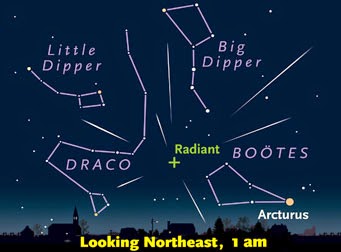| Online: | |
| Visits: | |
| Stories: |
First Weekend of the New Year Brings Quadrantid Meteor Shower
Discussions concerning all matters of humanity’s ascension into a higher dimensional existence culminating in 2012
Excerpt from savingadvice.com
For those who want to save money, one of the best free resources available to everyone are nature’s displays. The first weekend of the New Year will begin with a bang, although this bang will be of interstellar origins. This weekend (Jan. 3), the first meteor display of 2015 will reach its peak on Saturday night in a display of lights known as the Quadrantid meteor shower. According to science reporter Geoff Gaherty, “Meteor shows are usually named after the constellation in the sky where their radiant is located: the point in the sky from which they appear to radiate. Thus, the Perseids [showers] are named for Perseus and the Geminids [showers] are named for Gemini.”
Interestingly, Gaherty informs the reader that “there is no constellation named Quadrans” whence scientists derived the name Quadrantid. Instead, there was once the Quadrans Muralis constellation, which became a part of the constellation Bootes in 1922. The name of the meteor, however, was retained.
Quadrantids are also known to be a January meteor shower, as opposed to the more famous Perseids observed in August or the Geminids seen in December. Additionally, quadrantid meteors are less frequently observed than the other two meteor showers given that its peak intensity lasts only hours. Still, Gaherty writes that the Quadrantid shower “can produce as many bright meteors during its peak as the more famous Perseids.” Thus, in order to view this spectacular display, “timing is everything.”
Using past observations, researchers predict that the peak of 2015′s Quadrantid meteor shower will occur at 9 p.m. EST on Jan. 3. “During this time, the radiant will be close to the northern horizon and there is a good chance of seeing…meteors coming in close to the horizon to the east and west.”
The radiant, however, is expected to rise higher in the northeastern sky, until more meteors become visible in the east. According to Gaherty, the best time to then observe the Quadrantids will be between midnight and 2 a.m. (some reports say dawn) in the Northern Hemisphere.
Unfortunately, the shooting stars may be hard to view because of an almost-full moon on Saturday, which will radiate its own impressive brightness. Still, NASA predicts that at the peak of the Quadrantid shower, approximately 80 meteors an hour will be released, which should be remarkable in its own right. http://ascensionearth2012.blogspot.com
Source: http://www.ascensionearth2012.org/2015/01/first-weekend-of-new-year-brings.html





